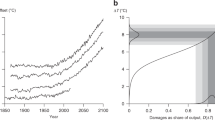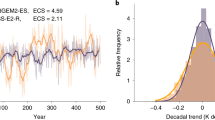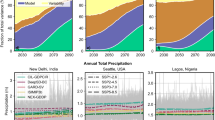Abstract
Arising from: G. C. Hegerl, T. J. Crowley, W. T. Hyde & D. J. Frame Nature 440, 1029–1032 (2006)10.1038/nature04679; Hegerl et al. reply
Similar content being viewed by others
Main
Based on reconstructions of past temperatures from proxy data, Hegerl et al.1 estimate a confidence interval for climate sensitivity that suggests a substantially reduced probability of very high climate sensitivity compared with previous empirical estimates. Here I show that the inference procedure used by Hegerl et al. neglects uncertainties in temperature reconstructions and in the estimated climate sensitivity and can even be used to infer that the climate sensitivity is zero with vanishing uncertainty. Similar procedures based on temperature reconstructions from proxy data generally underestimate uncertainties in climate sensitivity.
Hegerl et al.1 relate a given univariate time series, θi, composited from climate proxies, to a time series, Ti, of mean temperatures by using an errors-in-variables model

with regression coefficient β and uncorrelated errors ηi and ɛi with zero mean and variances ση2 and σɛ2. The subscript i indexes time, and 〈·〉 denotes a temporal mean. Estimating the mean values 〈T〉 and 〈θ〉 by sample means T̄ and θ̄, Hegerl et al. obtain an estimate  of the regression coefficient β from a calibration period in which proxy data, θi, and instrumental temperature data, Ti, overlap. With model (1) and the estimated parameters, they infer expected values of past temperature anomalies (“reconstructed temperature anomalies”) as T̂i′ (
of the regression coefficient β from a calibration period in which proxy data, θi, and instrumental temperature data, Ti, overlap. With model (1) and the estimated parameters, they infer expected values of past temperature anomalies (“reconstructed temperature anomalies”) as T̂i′ ( ) =
) =  (θi − θ̄), given proxies θi in a reconstruction period. They then simulate temperature anomalies, T̂i′ (EBM), with an energy-balance model (EBM) for a range of forcing and model parameters including the climate sensitivity and determine the likelihoods of the temperature-anomaly time series T̂i′ (
(θi − θ̄), given proxies θi in a reconstruction period. They then simulate temperature anomalies, T̂i′ (EBM), with an energy-balance model (EBM) for a range of forcing and model parameters including the climate sensitivity and determine the likelihoods of the temperature-anomaly time series T̂i′ ( ) given EBM parameters from the sum of squares of the residuals ri (
) given EBM parameters from the sum of squares of the residuals ri ( ) = T̂i′ (EBM) − T̂i′ (
) = T̂i′ (EBM) − T̂i′ ( ). From these likelihoods, varying
). From these likelihoods, varying  within estimated confidence intervals, they obtain the marginal distribution of climate sensitivities that led to the conclusion of a reduced probability of high climate sensitivity.
within estimated confidence intervals, they obtain the marginal distribution of climate sensitivities that led to the conclusion of a reduced probability of high climate sensitivity.
Because this procedure treats reconstructed temperature anomalies, T̂i′ ( ), as if they were known temperature anomalies, taking into account uncertainty only in
), as if they were known temperature anomalies, taking into account uncertainty only in  , it neglects uncertainties in reconstructed temperature anomalies that contribute to uncertainties in the estimated climate sensitivity. The procedure does not take into account the uncertainties in reconstructed temperature anomalies T̂i′ (
, it neglects uncertainties in reconstructed temperature anomalies that contribute to uncertainties in the estimated climate sensitivity. The procedure does not take into account the uncertainties in reconstructed temperature anomalies T̂i′ ( ) that arise because the mean values T̄ and θ̄ are estimated rather than known and the uncertainties reflected in the error terms ɛi and ηi in model (1). (As a result, the estimated margins of error of reconstructed temperature anomalies vanish if the temperature anomalies vanish; see Table S1 of Hegerl et al.1.)
) that arise because the mean values T̄ and θ̄ are estimated rather than known and the uncertainties reflected in the error terms ɛi and ηi in model (1). (As a result, the estimated margins of error of reconstructed temperature anomalies vanish if the temperature anomalies vanish; see Table S1 of Hegerl et al.1.)
What should enter the calculation of the likelihoods of the temperature-anomaly time series T̂i′ ( ) is the estimated variance of the residuals ri (
) is the estimated variance of the residuals ri ( ), not just the sample variance proportional to their sum of squares, Σiri2. In addition to the contribution taken into account by Hegerl et al.-1, the contribution associated with the variance var(
), not just the sample variance proportional to their sum of squares, Σiri2. In addition to the contribution taken into account by Hegerl et al.-1, the contribution associated with the variance var( ) of the regression-coefficient estimate1,- a variance associated with the sample means and the variance β2ση2 + σɛ2 of the error terms, contributes to the residual variance. The error variance β2ση2 + σɛ2 would contribute to the residual variance even if the parameters β, 〈θ〉 and 〈T〉 were known, which demonstrates that the unaccounted variance contribution is generally non-zero, irrespective of how parameters are estimated. Adding estimates of the unaccounted variances to the sample variance of the residuals does not affect the combination of EBM parameters that minimize the residual variance, but it does affect uncertainty estimates by increasing the minimum residual variance. It is inconsistent to estimate temperature variances as sample variances from the reconstructed anomalies T̂i′ (
) of the regression-coefficient estimate1,- a variance associated with the sample means and the variance β2ση2 + σɛ2 of the error terms, contributes to the residual variance. The error variance β2ση2 + σɛ2 would contribute to the residual variance even if the parameters β, 〈θ〉 and 〈T〉 were known, which demonstrates that the unaccounted variance contribution is generally non-zero, irrespective of how parameters are estimated. Adding estimates of the unaccounted variances to the sample variance of the residuals does not affect the combination of EBM parameters that minimize the residual variance, but it does affect uncertainty estimates by increasing the minimum residual variance. It is inconsistent to estimate temperature variances as sample variances from the reconstructed anomalies T̂i′ ( ) as if they were known anomalies while modelling temperatures according to model (1) (ref. 2). If an inference procedure for instrumental temperatures is used for reconstructed temperatures, the additional variance contributions must be taken into account to avoid underestimation of variances and uncertainties.
) as if they were known anomalies while modelling temperatures according to model (1) (ref. 2). If an inference procedure for instrumental temperatures is used for reconstructed temperatures, the additional variance contributions must be taken into account to avoid underestimation of variances and uncertainties.
As an example of how the procedure used by Hegerl et al. leads to underestimation of uncertainties in climate sensitivity, consider a hypothetical proxy time series that is constant and equal to the sample mean θi = θ̄ in the reconstruction period and is otherwise arbitrary. The reconstructed temperature anomalies, T̂i′ ( ), are zero for any
), are zero for any  . It follows that the sample variance (∝Σiri2) of the residuals ri(
. It follows that the sample variance (∝Σiri2) of the residuals ri( ) between the reconstructed and simulated temperature anomalies is minimized and is equal to zero for zero climate sensitivity and any value of the forcing parameters (provided that the EBM simulation yields vanishing temperature anomalies for zero climate sensitivity, which can always be achieved with the normalizations of Hegerl et al.). For non-zero climate sensitivity, which leads to non-zero residuals, the procedure of Hegerl et al. gives a vanishing likelihood of the corresponding time series of reconstructed temperature anomalies, T̂i′ (
) between the reconstructed and simulated temperature anomalies is minimized and is equal to zero for zero climate sensitivity and any value of the forcing parameters (provided that the EBM simulation yields vanishing temperature anomalies for zero climate sensitivity, which can always be achieved with the normalizations of Hegerl et al.). For non-zero climate sensitivity, which leads to non-zero residuals, the procedure of Hegerl et al. gives a vanishing likelihood of the corresponding time series of reconstructed temperature anomalies, T̂i′ ( ). The result for the reconstruction period would be an estimate of zero climate sensitivity with probability one — that is, without any uncertainty. If, additionally, instrumental temperature data in the calibration period are taken into account to estimate climate sensitivity, their relative influence can be made arbitrarily small by extending the hypothetical proxy time series into the distant past, leaving the result of zero climate sensitivity with vanishing uncertainty unchanged.
). The result for the reconstruction period would be an estimate of zero climate sensitivity with probability one — that is, without any uncertainty. If, additionally, instrumental temperature data in the calibration period are taken into account to estimate climate sensitivity, their relative influence can be made arbitrarily small by extending the hypothetical proxy time series into the distant past, leaving the result of zero climate sensitivity with vanishing uncertainty unchanged.
Even if the inferential errors are corrected, similar procedures based on temperature reconstructions from proxy data generally underestimate uncertainties in reconstructed temperatures and hence in climate sensitivity. Climate proxies are often selected on the basis of their correlations with instrumental temperature data, as in the reconstruction3 underlying the analysis of Hegerl et al.1. Using such proxies in regression models to reconstruct past temperatures leads to selection bias4, resulting in an overestimation of the correlation between proxies and temperatures and an underestimation of uncertainties. There are also structural uncertainties: in the structure of the regression model used to reconstruct temperatures (for example, error terms may be correlated if there are non-climatic, low-frequency variations of proxies) and in the structure of the EBM. Hegerl et al. acknowledge such structural uncertainties but do not scrutinize them quantitatively. The structural uncertainties may be large compared with the parametric uncertainties taken into account in the inference procedure5.
For these reasons, uncertainties in temperature reconstructions and climate sensitivity are greater than those given by Hegerl et al.1.
References
Hegerl, G. C., Crowley, T. J., Hyde, W. T. & Frame, D. J. Nature 440, 1029–1032 (2006).
Little, R. J. A. & Rubin, D. B. Statistical Analysis with Missing Data 2nd edn (Wiley, New York, 2002).
Hegerl, G. C. et al. J. Climat. (in the press).
Miller, A. J. J. R. Statist. Soc. A 147, 389–425 (1984).
Draper, D. J. R. Statist. Soc. B 57, 45–97 (1995).
Author information
Authors and Affiliations
Ethics declarations
Competing interests
The author declares no competing financial interests.
Rights and permissions
About this article
Cite this article
Schneider, T. Uncertainty in climate-sensitivity estimates. Nature 446, E1 (2007). https://doi.org/10.1038/nature05707
Published:
Issue Date:
DOI: https://doi.org/10.1038/nature05707
This article is cited by
-
Uncertainty in climate-sensitivity estimates (Reply)
Nature (2007)
Comments
By submitting a comment you agree to abide by our Terms and Community Guidelines. If you find something abusive or that does not comply with our terms or guidelines please flag it as inappropriate.



